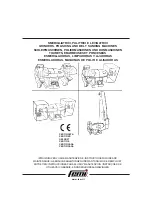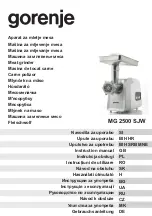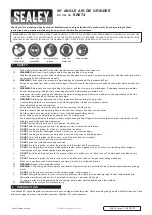
15 ENGLISH
For 115 mm (4 - 1/2") / 125 mm (5")
model
When installing the abrasive cut-off wheel:
►
Fig.20:
1.
Lock nut
2.
Abrasive cut-off wheel
(Thinner than 4 mm (5/32"))
3.
Abrasive cut-
off wheel (4 mm (5/32") or thicker)
4.
Inner
flange
When installing the diamond wheel:
►
Fig.21:
1.
Lock nut
2.
Diamond wheel (Thinner than
4 mm (5/32"))
3.
Diamond wheel (4 mm
(5/32") or thicker)
4.
Inner flange
Operation with wire cup brush
Optional accessory
CAUTION:
Check operation of brush by run-
ning tool with no load, insuring that no one is in
front of or in line with brush.
CAUTION:
Do not use brush that is damaged,
or which is out of balance.
Use of damaged brush
could increase potential for injury from contact with
broken brush wires.
►
Fig.22:
1.
Wire cup brush
Remove the battery cartridge from the tool and place it
upside down allowing easy access to spindle.
Remove any accessories on spindle. Thread wire cup
brush onto spindle and tighten with supplied wrench.
NOTICE:
Avoid applying too much pressure
which causes over bending of wires when using
brush.
It may lead to premature breakage.
Operation with wire wheel brush
Optional accessory
CAUTION:
Check operation of wire wheel
brush by running tool with no load, insuring that
no one is in front of or in line with the wire wheel
brush.
CAUTION:
Do not use wire wheel brush that
is damaged, or which is out of balance.
Use of
damaged wire wheel brush could increase potential
for injury from contact with broken wires.
CAUTION:
ALWAYS use guard with wire
wheel brushes, assuring diameter of wheel fits
inside guard.
Wheel can shatter during use and
guard helps to reduce chances of personal injury.
►
Fig.23:
1.
Wire wheel brush
Remove the battery cartridge from the tool and place it
upside down allowing easy access to spindle.
Remove any accessories on spindle. Thread wire wheel
brush onto spindle and tighten with the wrenches.
NOTICE:
Avoid applying too much pressure
which causes over bending of wires when
using wire wheel brush.
It may lead to premature
breakage.
MAINTENANCE
CAUTION:
Always be sure that the tool is
switched off and the battery cartridge is removed
before attempting to perform inspection or
maintenance.
NOTICE:
Never use gasoline, benzine, thinner,
alcohol or the like. Discoloration, deformation or
cracks may result.
Air vent cleaning
The tool and its air vents have to be kept clean.
Regularly clean the tool's air vents or whenever the
vents start to become obstructed.
►
Fig.24:
1.
Exhaust vent
2.
Inhalation vent
Remove the dust cover from inhalation vent and clean it
for smooth air circulation.
►
Fig.25:
1.
Dust cover
NOTICE:
Clean out the dust cover when it is
clogged with dust or foreign matters.
Continuing
operation with a clogged dust cover may damage the
tool.
















































